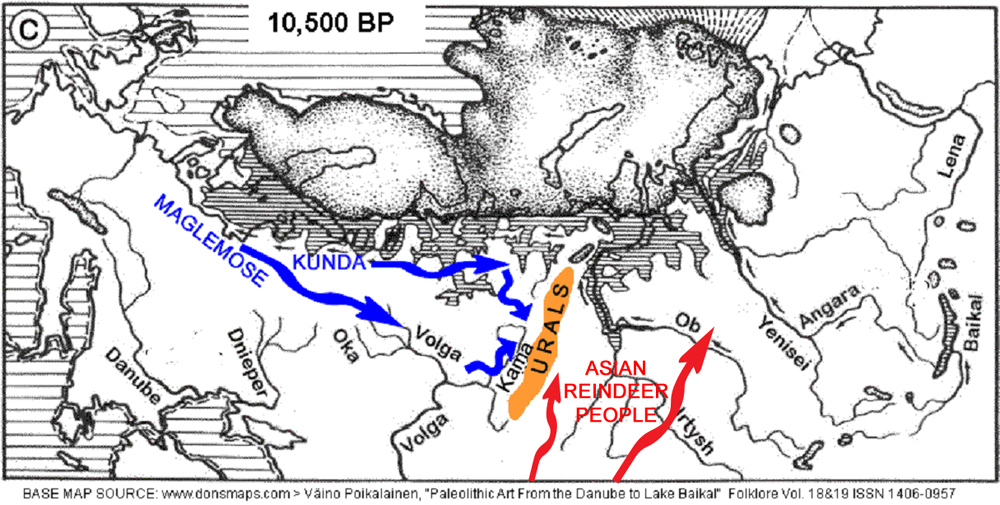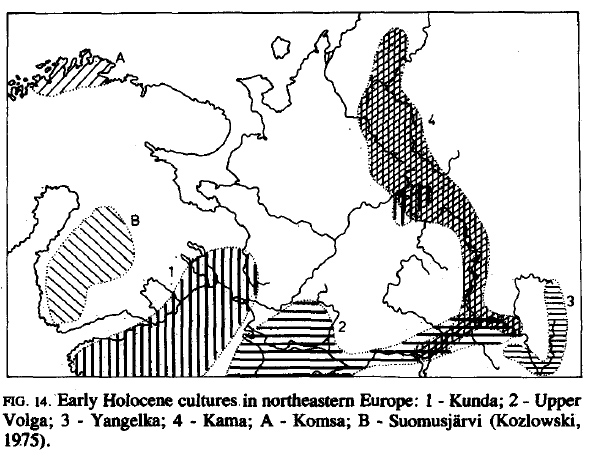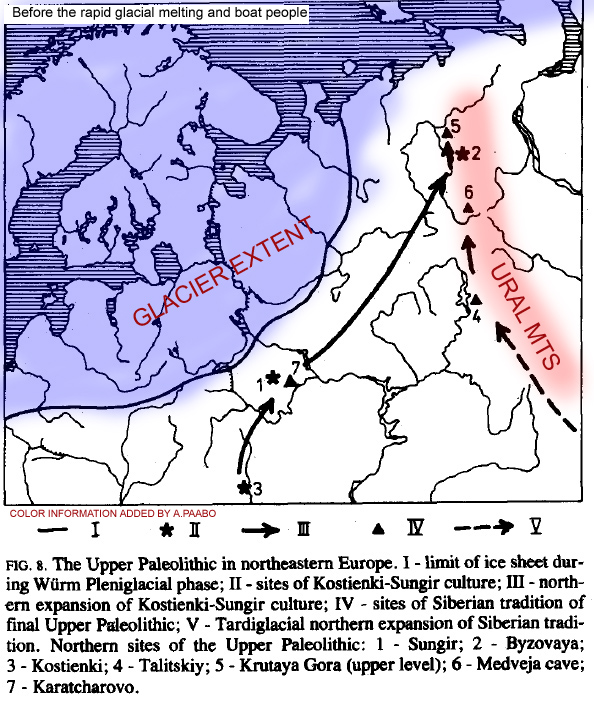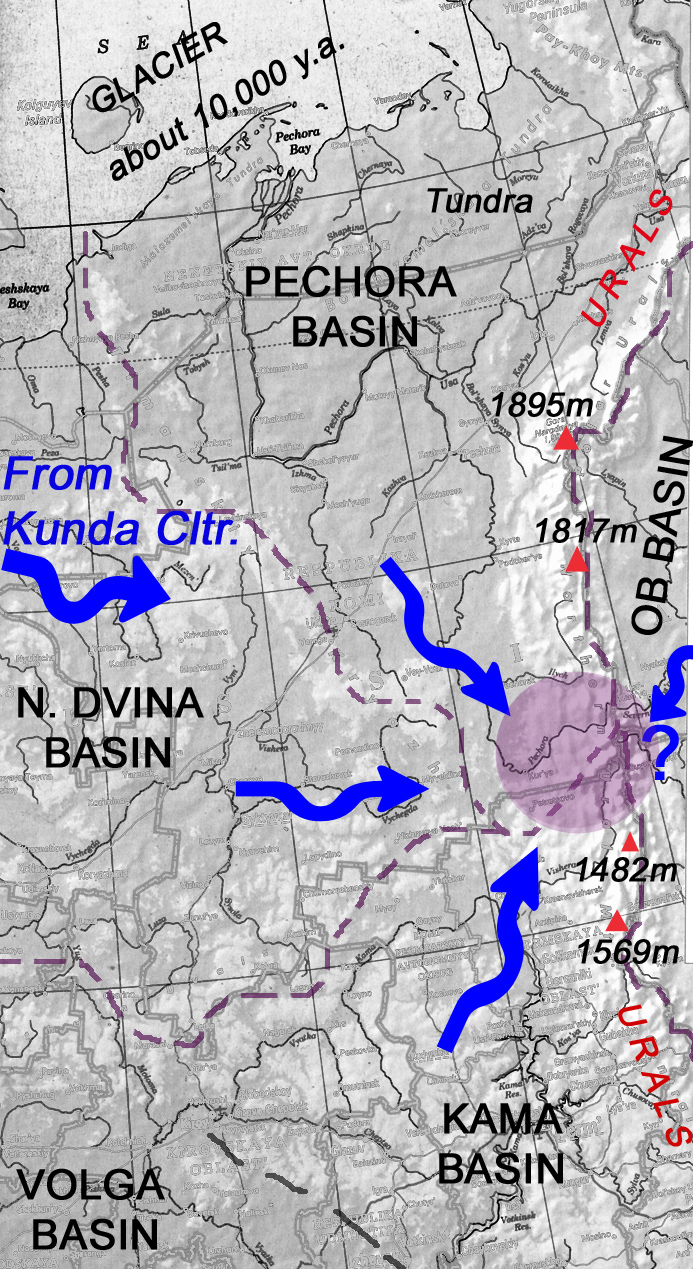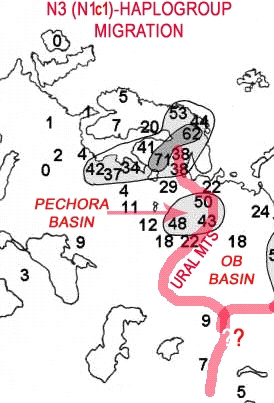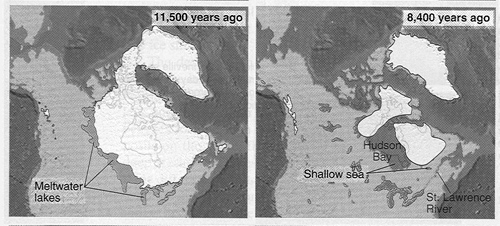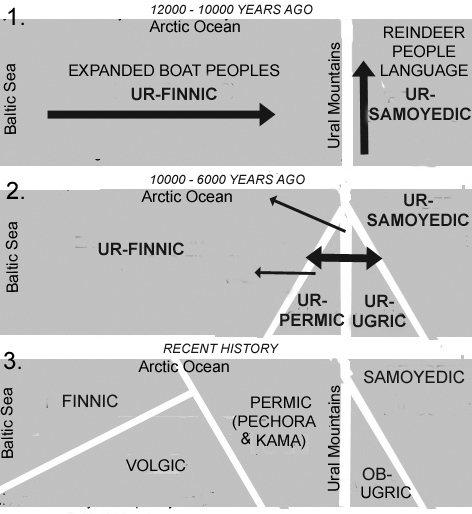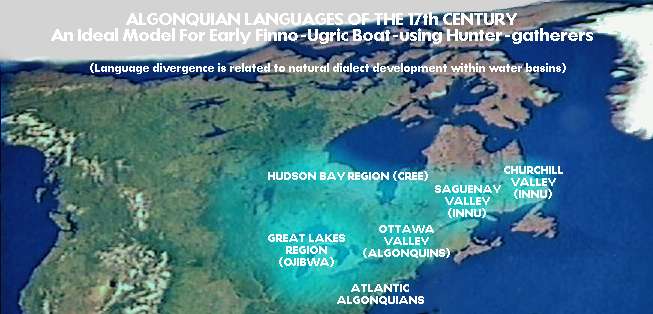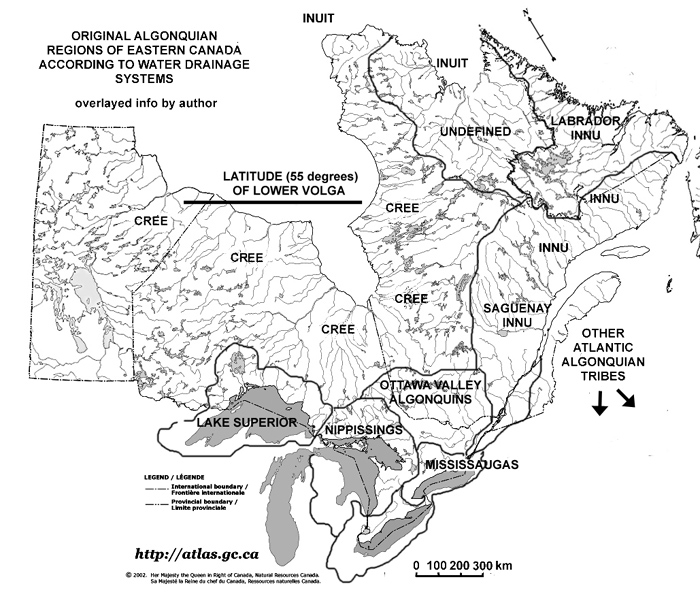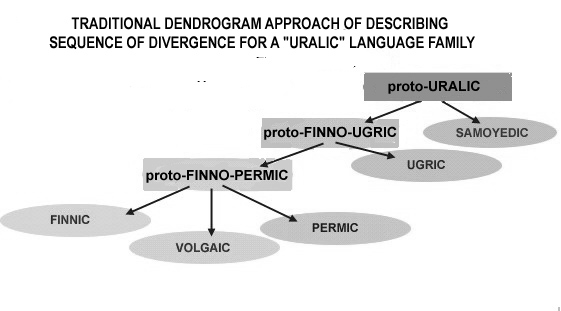DIALECTIC
SUBDIVISION OF ALGONQUIAN BOAT PEOPLES ACCORDING TO WATER BASINS
IN EASTERN CANADA
The
following are some of the
mistakened beliefs I have found among traditional linguists, which I
have
encountered when investigating this subject. It is not unusual for
fields of
science to hold onto ideas that are old
but entrenched and difficult to displace. The Figure below
presents a
modern version of the original theory when almost nothing was known
about the
early circumstances in northwest Eurasia, nor
even
linguistics itself. The linguists simply adopted a new methodology and
proceeded in the vaccuum of information of the day. It is a model that
today
could be created by a schoolboy or schoolgirl. It is about as antique
as the
early belief that the earth was flat. And yet there are still some
misguided
linguists who still follow it and defend it
In 2017 I had a lengthy email debate
with a hardcore defender of the archaic theory, and learned a great
deal of how they justified their position in continuing to follow it.
The following are some of the beliefs, some obviously ridiculous and
defensive, and my responses to them.
1. THE BELIEF THAT
LANGUAGES MUST EXIST AS INDEPENDENT ARTIFACTS?
Today there are thousands of languages, but observers – especially past
linguists who have studied the large numbers of languages in North
America at the time of European contact – have noted that similar
languages sometimes differ slightly and are dialects to each other, and
sometimes are so different that it is difficult for one to understand
the other. This is the result of the fact that languages are not
distinct tools, artifacts, with an independent existence, but that
languages in reality exists in a fluid state, often part of a continuum
of changing – converging in some ways, diverging in others, from their
prior form or from nearby related languages. Humans in the natural
state will generate a continuum based on a single language that changes
dialectically in such a way that nearby dialects are close to each
other, while dialects far away can be so different as to be regarded as
related languages rather than dialects. In the natural state,
therefore, there is a single language with dialects developed from
patterns of contact – much contact causing dialects to resist change,
little contact allowing the dialects to be more easily changed.
What we know as “languages” are the consequence of dramatic changes due
to some external factors causing those dramatic changes in a continuum.
The most common natural factors causing the dramatic changes, and even
sharp discontinuities, were geographic barriers or boundaries. For
example, originally there was a continuum of a single Finnic language
going up the east Baltic coast, that varied dialectically in the
fashion described above, but when it came to the Gulf of Finland, there
was a sharp discontinuity caused by the Gulf of Finland geographic
barrier. Of course to some extent, there was still some continuity with
dialects going around the east end of the Gulf of Finland.
Another example is that we must regard the Ural Mountains as a barrier
causing both sides to developing linguistically a little differently
even if both languages developed from the same circumstances of contact
between the Ur-Finnic and Ur-Samoyedic languages. I have also above
stressed that for boat-oriented nomadic peoples, the boundaries of the
inhabited water system form soft barriers to communication that caused
the dialects in one language to be different from the dialects in
another language.
But MOST languages today are not the result of natural barriers, but
the result of creation of artificial nations, and the imposition of
national languages on governed regions that originally contained the
contiinuum of a single language. And that national language was based
on the language of the strongest group.
That means when linguistics analyzes modern national languages, defined
by arbitrary national boundaries, it is not dealing with language in a
pure way, and as a result the results are somewhat contrived.
Significantly when linguistics of Finnic languages jumps from Estonian
to Livonian to Finnish to Karelian, and so on, it is not seeing the
continuum, but leaping between languages that for one reason or another
have been politically allowed to survive. All the dialects that
originally existed between those surviving languages are treated as if
they never existed.
But linguistics would be unable to analyze a continuum. Imagine that
the modern Algonquian linguistic divisions created by water system
boundaries, did not exist. There would be a single Algonquian language
continuum, changing smoothly from tribe to tribe (we can allow minor
steps of change from tribe to tribe), from the Atlantic to the middle
of Canada.
This is very important, because comparative linguistics would not work
on a continuum. Comparative linguistics has to deal with situations in
which an original language breaks up into two strong dialects which
then generates offsprings up to the modern day. Linguistics can only
compare surviving descendants of the original dialectic divergence.
Linguistics can only compare surviving languages. It therefore cannot
identify descendants of dialects when they did not produce descendant
languages that reached the modern day. For example if there once
existed Finnic languages say in the aboriginal peoples of Scandinavia,
comparative linguistics cannot see it. Insofar as comparative
linguistics today does not even acknowledge the possibility of extinct
languages, it is unlikely to present a true picture of language
evolution.
If we went back to the Ice Age, we would tend to find single languages
spread practically endlessly in a continuum. Discontinuities could be
caused by geographical barriers.. Common sense suggests that there
would have been some natural barriers too in terms of how peoples
following one way of life (horse hunters) occupied a different
environment than peoples following another way of life (say, reindeer
hunters) But there would be underlying continuity where an ancestral
people diverged between those who went in two different directions.
Thus all languages are not of the same nature and we have to be
restrained in what we conclude from them, while others may still
reflect a natural continuum among aboriginal peoples.
2. THE BELIEF THAT
LANGUAGES HAVE TIGHT ORIGINS
This is the silliest claim by traditional “Uralic” linguists who want
to find an original “Uralic” parent language near the Ural Mountains.
This silly idea arises only when linguistics assumes language evolves
from a group splitting off from a parent language and migrating away.
Any theory that involves migrating away, requres that the parent
language has a tight origin, If the language were widely distributed
over an entire water system, then moving away would require travelling
close to 1000km, to enter a new water system, since everyone still
within a water system would continue to have contact with the original
language. Obviously if we are dealing with highly nomadic peoples, the
correct mechanism for linguistic divergence is for the original broad
region of a single language, to subdivide dialectically for various
reasons. Since the geography is constant, the dialectic divergence will
be caused by natural continued divergence in the existing geography, or
from the inhabitants changing their way of life so at to reduce contact
throughout the original broad area. For example if members of a tribe
no longfer travelled the entire river system, but reduced their nomadic
ways to one branch of the river system, then dialectic divergence would
occur within that original complete river system.
It is important to note that when the region of a single language with
dialectic divergence (ie a continuum with some geographical influences
developing dialectic divergence) is not static. If we have
nomadic peoples maintaining a single language, over time, the language
of the whole region will evolve. What is constant is that there is
uniformity over a broad area, and then that subsequent contraction of
that broad area by further internal dialectic divergence, occurred to
that broad language at that time.
In other words, if we accept that there was once an Ur-Finnic language
that spread east as far as the Urals, we cannot claim that any modern
Finnic language looks like the Ur-Finnic language. However, the larger
the region of a single language, the more mobile the peple maintaining
that language was, the more inertia there would be in resisting
change in one location or another. Today we see the inertia in
English, where the amount of use of English causes resistance to
change. On the other hand, a local dialect in a community somewhere can
quickly change, as it has little inertia.
Thus to conclude – traditonal “Uralic” linguists have no choice but to
claim a tight origins near the Urals if they hold onto the idea of
divergence arising from migrations. A century ago, the very idea of
divergence by dialectic subdivision, was not acknowledged.
3.
THE BELIEF THAT THE SPREAD OF THE TRADITIONAL “URALIC” LANGUAGE EITHER
INVOLVED ENTRY INTO EMPTY LANDS AND/OR COMPLETELY DISPLACED THE ORGINAL
LANGUAGE
This idea is also necessary to defend the original “Uralic Language
Family” idea, in the face of increasing knowledge from archeology about
the expansion of humankind out of Ice Age Europe, a general
west-to-east expansion. Since the traditional “Uralic” theory
originally spoke about origins at the Urals around 4000 years ago, and
an arrival at the Baltic by 2000 years ago, archeological discoveries
forced the need to consider who were there at the Baltic BEFORE 2000
years ago. Scholars were confused, but generally assumed they were the
peoples historians called “Finns” or “Fenni” – people related to the
modern Saami (formerly “Lapps” and before that “Finns”). So the scholar
had to assume that the modern Finnic peoples, notably Finns, were not
descended from original people because they came from the east. But the
Saami language is close enough to Finnish to be considered related to
it.
So there existed a ridiculous situation. Theories that the arriving
Finns from the east influenced the Saami language. To summarize a whole
century of head-scratching, no evidence was found of an incoming people
from the east, displacing or even influencing any native people. When
archeology discovered that a “Comb-ceramic” material culture appeared
in the entire east Baltic with pottery styles that appeared to have
come from the upper Volga. This was enough for linguists to claim this
was the time of the migration. They only needed to push back the
arrival at the Baltic from 2000 years ago to 5,000 years ago!
Archeologists (ie Richard Indreko) dismissed the logic, saying the
influence from the upper Volga was purely a movement of a cultural
feature, not an entire tribe. There is evidence that long
distance trade, probably fur trade, began at that time. This is
confirmed by the spread of distribution of amber objects throughout the
“Comb-ceramic” area and also in ancient Babylonian tombs,
There was a spread of an influence up the Volga, but you do not require
an entire people to migrate to move something that more likely was
carried by small groups of traders, or simply carried by families to
gathering places.
It is also impossible to displace an original language with a new
language, unless the new language is very strong, expecially carried by
conquerors who kill off the indigenous peoples and force the new
language on the indigenous people. Something like that occurred in the
colonization of North America – hundreds of languages were wiped out.
But always in history, there will be remote places where the original
language endures. In the case of North America, languages have
survived, especially in the north. In the British Isles, the Pictish
language survived in the north until around the 10th century. It is
possible to think of the Saami language as a remnant of languages that
once dominated all of the Scandinavian Peninsula. Across Eurasia,
original languages can be found that have not been replaced.
Even in these cases of replacement, the new language is backed by major
powers. In order to argue an “Uralic” language completely replacing the
original language (the Ur-Finnic) we need to find the language being
spread by very powerful people bent on conquest and domination. History
shows nothing.
Therefore if there is evidence in Finnic languages of origins that
point back east as far as reindeer people, then it is more likely the
original Ur-Finnic language was simply influenced by a language that
was already Ur-Finnic at its foundations. Below we will propose that
the Ur-Finnic peoples who reached the Urals, adopted aspects of the
language of the reindeer people speaking Ur-Samoyedic, and the
resulting language, which I am calling “Ur-Permic” then began to exert
influences back east, first Ur-Permic on the original Ur-Finnic Volgic
dialect, and then the slightly changed Volgic dialect in turn
influencing the Ur-Finnic near the Baltic. The influences could indeed
spread in step by step through boat peoples according to the major
water systems. These influences would be superimposed onto the original
and continuing internal dialectic divergence, resulting in the founding
languages of the later development of the descendant languages that
survived to the modern day.
However, a century ago, linguists wanted desparately to discover a
linguistic family tree, and to use the migrations approach, and employ
the new methodology, and there was no consideration of the simple
spread of linguistic influences in diminishing degrees with
distance. ( Volgic fur traders could have been the instruments of
the spread of influences.).
4. THE BELIEF THAT
INFLUENCES – SUCH AS BORROWINGS – CAN BE IGNORED BY LINGUISTS OR CAN BE
DETECTED BY LACK OF COGNATES
One of the claims made by a traditional “Uralic” linguist was that a
linguist cannot confuse similarity from convergence of two languages
for similarity from divergence from a common parent. The reason,
was the claim, is that convergence is about borrowing and borrowed
words can be detected from lack of cognates. Original words in a
language, eventually develop words of related form and meaning, that
are known as cognates. New words borrowed from other languages will not
have existed in the language long enough to develop a history that
leads to speakers developing cognates from them.
However, if a borrowed word is very popular, then it will become part
of the language more quickly. But most of all, if the borrowing
occurred a long time ago, then it would behave like any other original
word, and its borrowed origin would not be detectable. As we see in
these pages, the contact between the Ur-Finnic boat peoples and the
Ur-Samoyedic reindeer people occurred as early as about 10,000 years
ago. That is 5,000 year before the linguistic analysis using only the
migration-divergence approach, suggests. What we have here – if you
follow the story told by archeology and population genetics – is
borrowing that took place so long ago that languages that developed
from convergence between Ur-Finnic and Ur-Samoyedic will show
similarities that can be erroneously interpreted as divergence from a
“Uralic” original language, rather than an early convergence between
Ur-Finnic and Ur-Samoyedic as early as 10,000 years ago. (Even some
millenia later, there will still be enough time for the evidence of the
original borrowing to be faded.)
It is therefore easily possible that traditional linguists mistook the
convergence between two original languages to be a divergence from a
hypothetical parent language.
Traditional historical comparative linguistics is now obsolete because
most languages evolved by convergence – often going back to the end of
the Ice Age – and yet comparative linguistic methodology is unable to
detect or analyze convergence
5. THE BELIEF THAT
LANGUAGE, CULTURE, AND GENETICS ARE INDEPENDENT AND ONE HAS NO BEARING
ON THE OTHER
Today, we can find many examples of the independence of language used,
culture (way of life) and genetics. For example we could have a
black skinned African, speaking Finnish, and practicing, say, Japaneses
culture.
But in the beginning – we have to realize – language originated as a
tool that referred to the real world with symbols in order to
communicate information. Reindeer people needed to have words for
reindeer, their gender, the landscape, the spear, how to throw spears
at reindeer, etc. Thus in the beginning a language mirrored the
way of life. Language and culture were intimately connected.
However when reindeer people adapted to using boats to hunt seals in
the sea, the words for reindeer, and hunting reindeer on the tundra
were useless. Since no language is created entirely anew, what happens
is that the useless words are rarely used and forgotten. On the other
hand a new array of words was necessary to reflect, the new way of
life. New words were necessary for boat, the sea, seals, etc, and were
invented, often from new uses for old words. Could a seal be referred
to as a ‘water-reindeer’? The harpoon used to hunt seals could be
called ‘spear’.
Many words could be kept – words for sun, earth, land, sky, family
relations like ‘mother’ ‘father’, ‘family group’. Thus if a people
inherits a language but changes their way of life, there can be much
continuity in the original language. A language is more likely to shift
the meaning of existing words to suit new similar circumstances than
invent a completely new word that never existed before.
Now, regardng genetics. We know from the behaviour of our closest
relatives, the apes, that males forming groups are rulers and defenders
of territory. New males grow up and are included in the society of
males. There is a chief, a leader, among the males, and he is
challenged by younger males who wish to take over. Humans come from the
same place – males take charge, compete for leadership, and as a whole
defend the tribe against predators or rival tribes. Indeed we can look
beyond the apes to animals that encircle females and young against an
advancing pack of wolves.
That means in the human past, males passed down the role of defender of
the tribe generation after generation. Males never departed from their
tribe They could lead the creation of a new tribe, but If a tribe
existed, its males would never leave. They would fetch their wives from
neighbouring tribes. Wives would be brought home to live beside their
mothers. ‘
For this reason the population genetics DNA marker passed down from
father to son, is revealing. It generally shows that the apparent
migration of a male haplogroup, was in fact the migration of the tribe
they belonged to. Haplogroups pertaining to females do not reveal the
movement of tribes, because the males might obtain their wives from far
away. Furthermore the daughter of the wife might then be again taken
far away into another tribe. Hence DNA in female lineage only reveal a
blurry sense of the range of a tribe over a long period. Female DNA is
most useful for permanently settled peoples where males did not go very
far to find their wives.
Thus genetics of the male lineage help us trace the migration of tribes
from the apparent migrations of their haplogroup marker. If we
can now identify the cultural development of the tribe, we can also
link the male haplogroup to culture. For example on these pages we can
determine that the N-haplogroup was originally in males of reindeer
people, therefore when this haplogroup appears in boat people, we can
infer that there were times when tribes converted from reindeer people
way of life to boat people way of life, and then from then on the
N-haplogroup was spread via male offspring, through the boat people
world, radiating from the original source location.
In terms of language, we use common sense. If reindeer people change to
boat people, and interract with them, they will have to learn the
language of the boat people to the degree of involvement. Language is
not independent of circumstances involving way or life and genetics.
Mixed marriages of course influence the use of a mixed languages, It
raises the use of the mixed language which then exerts a stronger
influence on unmixed dialects.
In general, all three parameters – language, culture, and genetics –
although independent, interract with one another in the real world, and
it is necessary to reconstruct the actual events before forming
conclusions.
Nothing is achieved by pursing each of these parameters independently
of the others since the nature of influences varies with total
circumstances.
6. THE BELIEF THAT
THERE IS NO LINGUISTIC CONTINUITY AND THAT LANGUAGES ARE CONSTANTLY
CHANGING
Since no language is developed from scratch, all language has some
degree of continuity from a language that came before and formed the
foundation for the new language. However, there could be truth that in
advanced civilizations, the language of a dominant people can displace
the language of a weaker people, and that such events can occur
alongside historical events, where one conquering people is later
conquered by another, For example, Britain was conquered by the Romans,
and most of it converted to Latin, but then five centuries later,
Britain was conquered by Germanic Saxons and Romans. But this kind of
behaviour is possible only in warring, competing, powers in
civilizations. In the case of the early languages of northwest Eurasia,
there is no evidence of any such conquering people or anyone able to
displace an original language. The fact that Finnic languages are
filled with imagery of marshy lands and boat use, do not suggest the
language came from another culture than the original Ur-Finnic of the
orignal expansion of boat people. But it is possible for Finnic to be
the consequence of being slightly changed by influences from the east
and north that originated in the early Ur-Samoyedic.
When dealing with aboriginal peoples we cannot claim any full
replacement of an original language by a new one, especially if there
aren’t even any examples of remnants of the original language in remote
places.
REFERENCES
The purpose of this article was to reinterpret the “Uralic Language
Family” theory after a century of accumulated knowledge in
archeology, and other applicable sciences. This re-interpretation is
entirely original in this article
Clark, G, 1967 World Prehistory,
Cambridge A celebrated text that summarized the accumulated
archeological discoveries up to that time. Since then the ideas have
simply been refined.
Jaanits, L. et al, 1982, Eesti Esiakalugu, Eesti Raamat, Tallinn In
Estonian, the product of Estonian archeological work during the Soviet
period, where the authors were able to access the work of other
archeology within the Soviet Union, not as accessible in the west.
Kozlowski J, and Bandi H-G
1984 The
Paleohistory of Circumpolar Arctic Colonization, Arctic 37 (4): 359-372
Article in English, where the investigation of the northeast Europe and
the Urals was only one section. I chose to use it for reference because
of this focus, and because it was a summary.
Pääbo, Andres
2002-2016 WEBSITE: The Origins and
Expansions of the Ancient Boat-oriented Way of Life: Basic Introduction
to the Theory of a Worldwide Expansion of Boat-peoples from Northern
Europe
, [
http://www.paabo.ca/uirala/ui-ra-la.html]
This is currently a layman-type site, not scholarly,
initially created for fun beginning 1998;; however the content contains
much that is original new theory from more or less raw data.
Rootsi,S., et al. 2006, A counterclockwise
northern route of the Y-chromosome haplogroup N from Southeast Asia
towards Europe”
European Journal of Human Genetics 15 (2): 204-11 Comment: This
is regarded as the authorative study suggesting the N1c1 haplogroup
migrated up the Ural Mountains and then continued west along the arctic
coast of northeast Europe to the northern Finland area, and then
diffused into the Finno-Ugric speakers from the locations of the
reindeer peoples. This agrees with the other paleoclimatological and
other facts. This association proves something that should be obvious
from the archeological/climatological story – that the Samoyedic
reindeer peoples were of Asian origins, not European.




